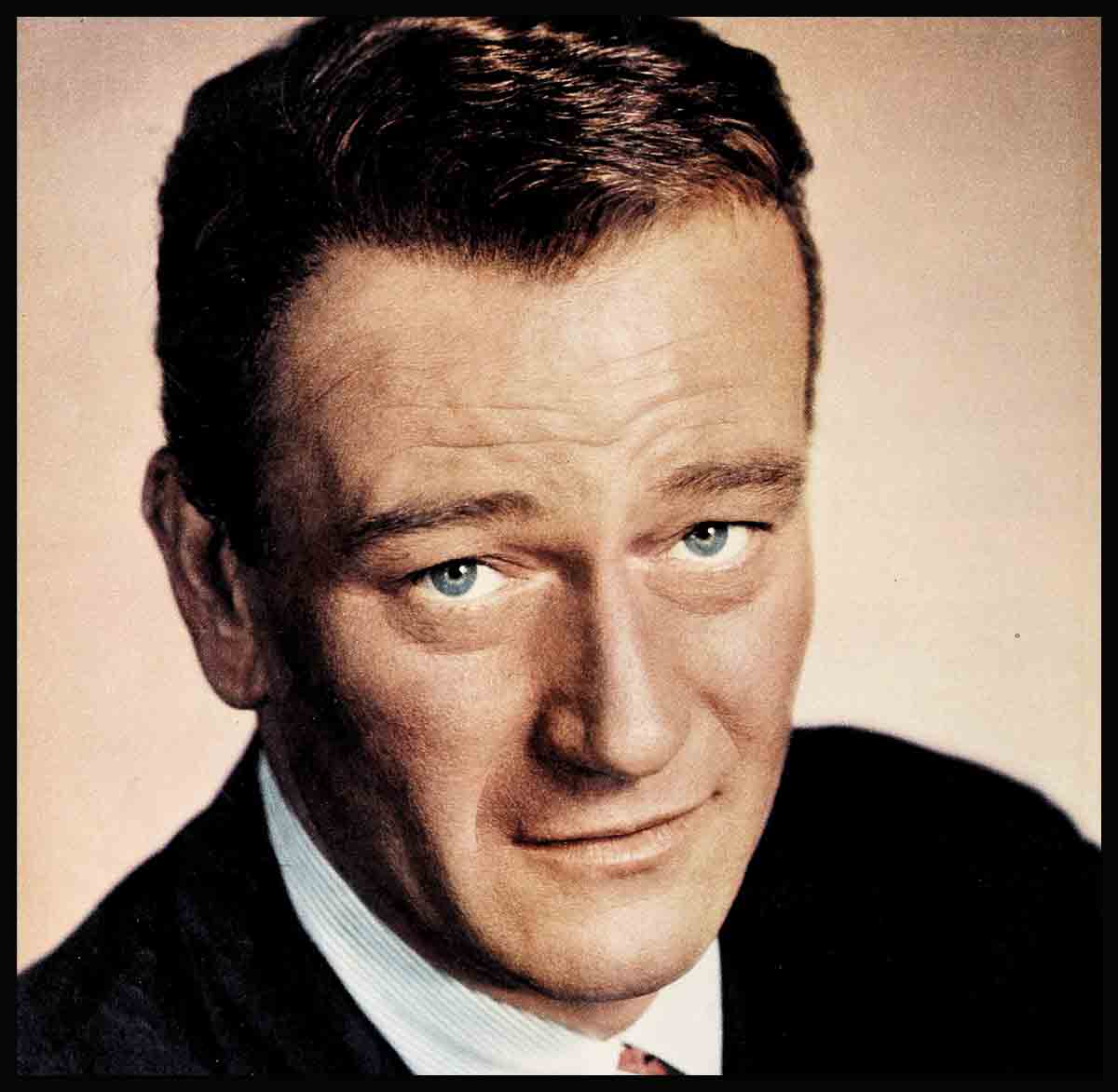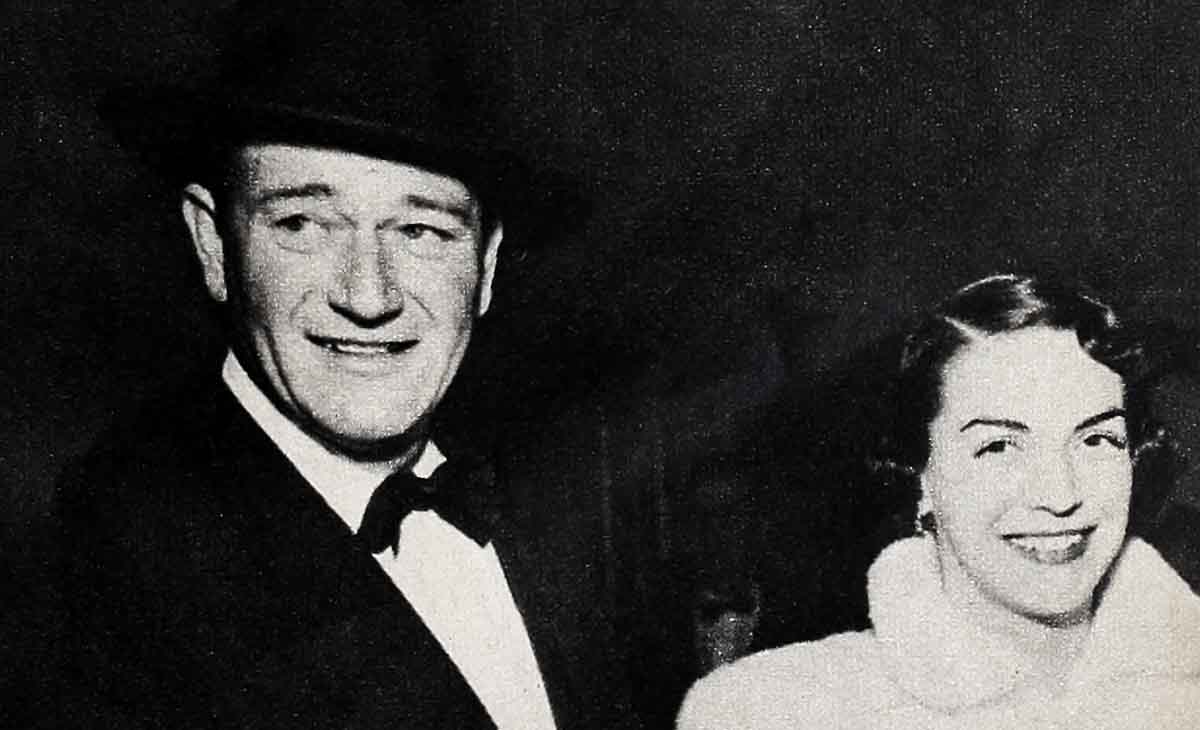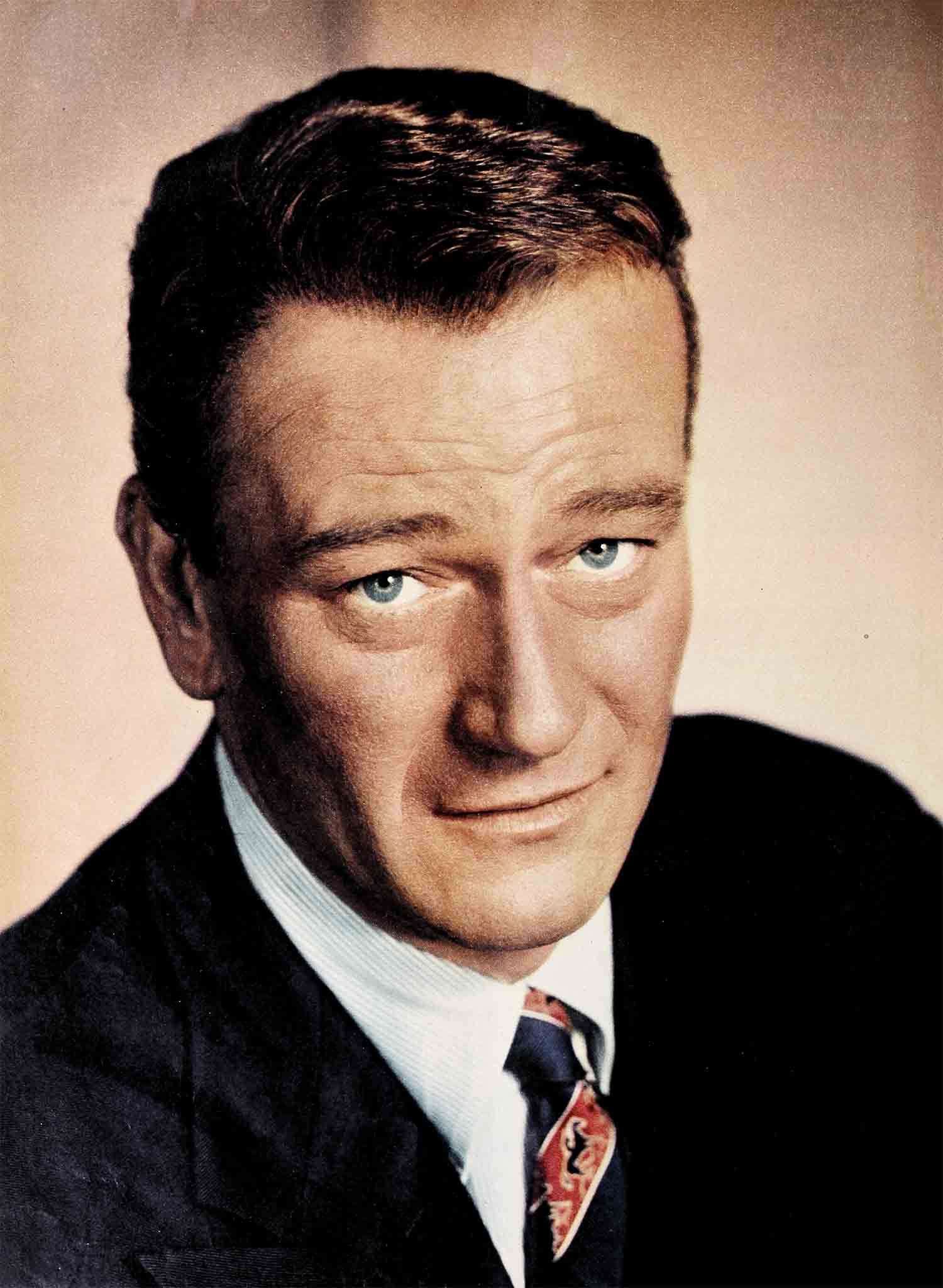
The Story John Wayne Has Never Told
It was one of those hot, muggy days of early summer. Despite the heat, one of the chambers occupied by the Superior Court of the County of Los Angeles was filled to capacity. The case being tried was listed in the legal record as Wayne vs. Wayne, a hearing for temporary alimony and other issues concerned with an eventual cross-filed separate maintenance and divorce action to be contested at a later date.
The principals in the proceedings were (1) a tall, attractive brunette woman in her mid-thirties named Esperanza Baur Wayne and (2) a massive hulk of a man well-known throughout all of the world as John Wayne, movie hero extraordinary and the idol of millions of lovers of reckless adventure.
The leading characters would no doubt have been enough to guarantee S.R.O., but the details of the litigation were of such an astonishing nature that they alone would have filled a courtroom even if the litigants had been just plain Mr. and Mrs. Smith.
You read the facts in the papers at the time, of course. Mrs. Wayne wanted $9,000 a month to keep eating and content until she came back to court for final action. She also wanted a fee of $40,000 for her lawyers—and an additional $20,000 for private detectives to keep an eye on her husband.
For twelve days Mrs. Wayne and her counsel spoke of derelictions and rights, at each day’s end piling another monetary demand atop the pile already stacked on the judge’s bench. And during those twelve days John Wayne sat on a hard chair in that courtroom and listened in mortification and fear to the creaks and rumbles of his world as it threatened to come tumbling about his ears.
It was during those twelve days that John Wayne, a man of forty-three, father of four, and reckoned to be a reasonably mature adult, really grew up. He has been a different man ever since. He will never be the same again. During those twelve days John Wayne took stock of himself, for as he heard the charges against him he, more than likely for the first time in his life, estimated the true values of his money, his standing in his profession, his friends and his loves. He put it rather simply when he stated to an associate: “I never knew I was so rich and interesting.”
Public feeling for John Wayne as a person, and not just a movie star, was established on the opening day of the trial. Wayne had never known or thought about it. He had always considered the nice things people said of him just a result of publicity, most of which he never read. And he hardly believed the tributes. Forcing his way past the heavy crowds jamming the court corridors every day, though, made him a believer.

The tribulations of John Wayne began twenty years ago when he was an ex-football player working as a prop man at the Fox Studio, hoping one day to get some sort of better job or get into a line of work less casual. The word career meant little to him. Actually, all he was interested in was getting married to Josephine Saenz, a girl with whom he’d been keeping company since he was a college freshman. The brokerage business could have had him easy in those days if he’d been approached, or the automobile business. But he was literally tapped on the shoulder by a director and shoved in front of a camera. And he only took the work because it paid better than propping.
When he did marry Josephine Saenz it was a reckless step. He had no real belief that acting was going to pay off—and he was sure he’d never be adept at saying, “They went that-a-way” with conviction. But he wanted to marry so badly that he swallowed his fear of that little glass eye on the camera each morning and rode into the sunset at the end of each week—another quick movie to his credit—for the few hundred dollars that took care of his rent and groceries.
Actually, although he was married to Josephine for more than ten years, John Wayne never got to know much more about her than he did the day they were wed. In the first place he was too busy making a living, for his fee was small during all those years and he had to keep hopping to keep abreast of his growing family, which eventually amounted to four children. An intimate of Wayne’s said at one time that he was never able to figure out why Duke and Josephine were divorced. “They never even had an argument,” he said. “Everything was fine—then it was all over.”
And to this day John Wayne himself can’t give you a sound reason for the break-up of his marriage. Speculators among the columnists have said, though, that the reason was neglect. And they blame it on the fact that Wayne worked so hard he never had any real contact with his wife and kids—and found his recreation with the stout lads who rode with him in the movies. Josephine has confidentially reported from time to time that it was mainly a difference in religious belief and Duke’s dislike for the social activities she thrived on. At any rate, divorce came and it was bitter to Wayne. It cost him all of the ambition he’d been building for ten years. He ran away, went to Mexico to escape the questions and what he earnestly felt to be the disgrace of the divorce. And he left almost as broke as when he married.

In retrospect, John Wayne’s romance with Esperanza Baur, whom he alls Chata, was not nearly as exciting as it has been pictured to be by magazine writers. Actually, as far as Wayne was concerned at the time, it was something better than being lonely and it was fun in the first few weeks. A terribly shy man with women, Wayne courted Chata in almost the way Emily Post would suggest. He sent flowers, brought small gifts and trotted her to luncheons and dinner parties. He seldom saw her alone. But he didn’t like any other girl and after a few months the thing got to the stage where Miss Post would have insisted on a proposal, so they got married instead.
The marriage lasted seven years. But it was doomed from the beginning. And the reason was simple. A man can’t buy happiness. That’s what John Wayne tried to do. He tried to buy it, he tried to negotiate for it, he tried to pretend it was there, he tried to put up with it. But nothing worked, because if ever two people were temperamentally unsuited they were John and Chata Wayne.
Most men would have accepted defeat early and packed, but Wayne was more afraid of divorce than a wrong marriage. He had no intimation of how distasteful divorce could be at that time; he was just against it on moral grounds. And he was a little afraid that he’d be lonely again. So he hung on and carried off the pretense of happiness as casually as a character in a Noel Coward play might have done in a similar circumstance.
Ask anyone who ever spent any time at the Wayne home and you’d probably hear that he was a victim of that old mother-in-law bogey. Chata Wayne’s mother, they say, ran the house and her daughter’s life. That sounds as reasonable as necessary, but it isn’t quite true. The truth can be stated much more simply. Incompatability. Absolute incompatability.
Chata Wayne was not a rich girl before she married John Wayne. But as soon as she was married the Wayne affluence took hold. The soft-eyed little girl became overnight a lady of means, a woman the butcher, the grocer, the banker and Wayne’s friends had to deal with warily.
Little men have poked fingers in John Wayne’s chest and told him off, and even though he could have broken them in two he took it, his only reaction being one of astonishment that someone could be so sore at him.
And a little woman can glare at him and he’ll run like a rabbit. It’s certainly not cowardice. It’s a concession to his realization that he can be wrong. One of the highlights of his court appearance was his shame-ficed admission that he and Chata had engaged in a few physical encounters. When accused by her attorney of having taken a whack at her, Wayne hung his head in the best Ringo Kid fashion and stammered: “The only time I lifted my hand to my wife was to defend myself.”
As the years progressed, John and Chata Wayne’s marriage grew more and more troubled. One by one the cronies he’d drunk with and played poker with for years drifted away. And finally the home became just a house, a neat orderly house with no cigar butts or poker chips lying around, no visitors but Chata’s friends—more mutual love than is found in a hotel.

Even today Hollywood isn’t aware of the number of times John Wayne left his wife—or she left him. But it was at least a dozen. Friends of the actor hated to ask questions and Wayne was never free to volunteer bulletins on his marital status, so it became routine to ask him to spend the night when he was calling on a chum and began to show signs of drowsiness. During the last two years of his marriage Wayne slept in more strange beds than a barnstorming bandleader.
But John Wayne’s best refuge was south of the border, in Mexico. It was to Mexico he’d fly when he had no place else to go and couldn’t get into his own front door. And to questions about the possibility of a rift in his marriage, he had the stock answer that everything was fine, he was just on his semi-annual vacation. But no one was around late at night when Wayne was alone and would pick up the telephone and tell his wife he was lonely and would like to come back.
The handwriting became legible on the wall in November, 1951, but nobody got wise. For days Wayne had strolled about his huge home in the San Fernando Valley trying to make up his mind. His wife and his mother-in-law were in the house, but he seldom saw them and they never spoke. His problem was immense—and there seemed no way out.
There was also the matter of money. No actor made more—and no actor paid out more. It was becoming like a treadmill that kept turning but never got anyplace. Late one evening, Wayne wrote a short note saying that if Chata wanted to, she would know where to find him. He packed a bag, caught an airplane, and the next night he sat beneath the stars in Acapulco determined to sweat it out.
He sat beneath those same stars for two months and nothing happened. And then the Christmas season came around. Mexico celebrates Christmas with great enthusiasm, and everywhere Wayne looked he saw the cheer that is universal at that season. It was everywhere but in the house Wayne had rented as a retreat. So on Christmas Eve, 1951, Wayne gave in. He flew to Mexico City early in the morning and took the afternoon plane to Los Angeles. But there was no reconciliation and the next night found him back under the stars at Acapulco.
John and Chata made one more try for happiness. It was called a second honeymoon by the papers. Wayne was to make a picture in Honolulu in mid-1952. Through the medium of friends he had persuaded Chata to see him, and they talked for several hours about their differences. Finally, almost as in the old days, she ran to his arms and they embraced and promised one another they’d stop all this silliness and begin all over again.
“I’ve got to leave the day after tomorrow,” Wayne said. “But you come along. We’ll go to the same places in the islands we went years ago—and everything will be all right again. Wait and see.”
They had the bridal suite on the boat, but they didn’t need it after the first five hundred miles at sea. And shortly after they arrived at Honolulu, Chata Wayne took off alone and returned to mother and the house in the Valley. John Wayne never saw her again until that first day in court.
During the months between the final separation and his day in court John Wayne threw himself headlong into work. He formed his own producing company and tried to forget about Chata. However, he found this impossible. Wherever he went a man or two men or three men followed. He had to make a trip to South America, scouting locations for one of his films—and everywhere he went one or two or three men followed him.
It was on this trip to Peru that Wayne met a tiny, vivacious little actress by the name of Pilar Pallete. She was similar to Josephine Saenz and Esperanza Baur only in appearance. She was interested in a career, but only mildly. She was interested in fun, but most assuredly. Wayne’s first interest in Pilar was as an actress. His company needed talent and Pilar, as her future will more than likely prove, is not only able but a unique personality, embodying much of the fire of the late Lupe Velez and much of the Latin beauty of Dolores Del Rio. Before he left her country, Wayne made arrangements for Pilar to come to Hollywood for a test. She did and was signed by his company.
Quite a little has been written romance-wise about John Wayne and Pilar Pallete, not much of it true. It is not true, for instance, that romance blazed at first sight. It is not true that Pilar has already promised to be the third Mrs. Wayne. But during the long months of loneliness the volatile little Peruvian has been a comfort and companion to a man in trouble—and for that reason may always remain close to John Wayne’s heart.
Any man must have a pretty girl opposite him at dinner, no matter how disillusioned he becomes. Pilar has been that woman to John Wayne. At first it was very carefully handled. The dinners were at the homes of friends. But one day, during his period in court, as a matter of fact, Wayne decided to the devil with deceit and subterfuge. He took Pilar to a night club—and while the flash bulbs were popping, he announced that she was under contract to his company, she should be seen in public and as, according to what he read in the papers, he was practically a single man, who better could she be seen with than him. Most of Hollywood applauded his stand.
Today that is the way things stand with John Wayne. The gossips report that the divorce trial will be a honey. That charges and counter charges will fly as in no other Hollywood litigation in years—and it might well be so.
Nobody, but nobody, can tell what will happen when the sound and the fury has subsided. But it is more than likely that John Wayne will marry again. He’s in his prime and hates to live alone. It’s premature, but the girl might well be Pilar. This is based on the only personal statement he has ever made about her. It was at a cocktail party a few weeks ago. A man noticed Pilar standing across the room talking to a group of girls. She made quite a picture.
“Now there,” said the guest, “is what I call a pretty girl. Is she with anyone?”
“Yes,” said Wayne. “She’s with me.”
Maybe she is.
(John Wayne will next be seen in “Island in the Sky” and “Hondo.”)
It is a quote. PHOTOPLAY MAGAZINE OCTOBER 1953




